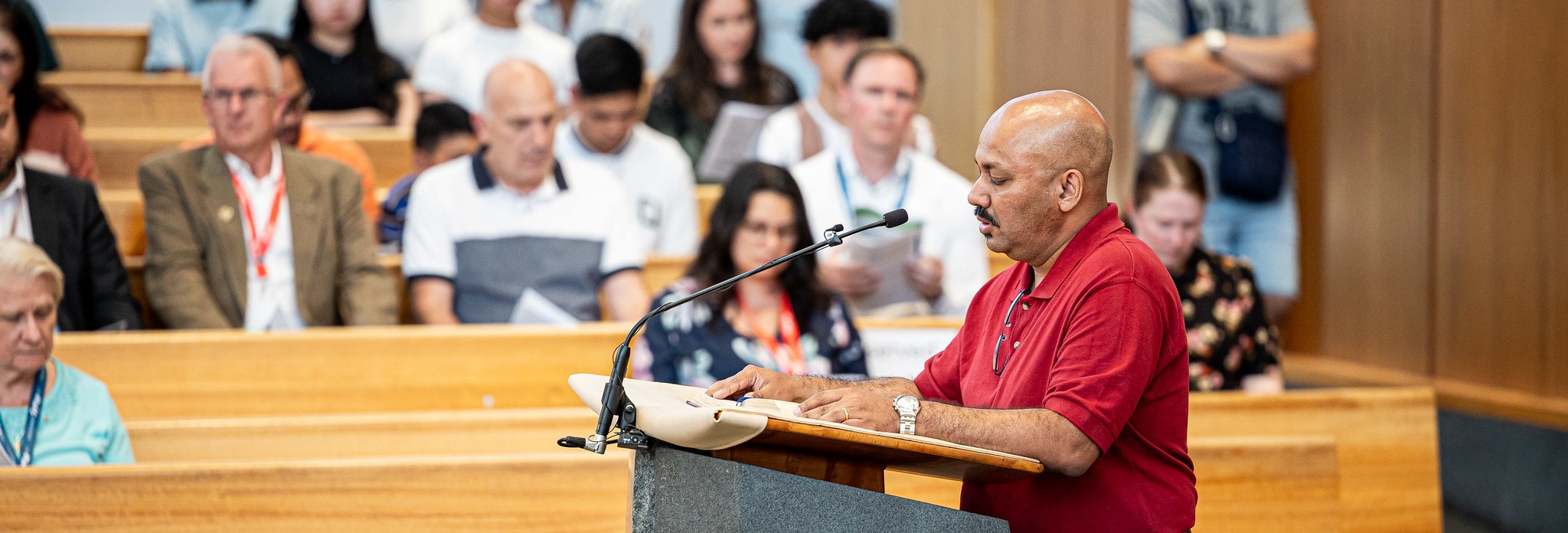The Prayer of Faithful
Cathy Murrowood

You have been given the task of preparing the Prayer of the Faithful and may be wondering where to begin. It will be helpful to find out more about this significant prayer and understand how to craft the different elements.
The Prayer of the Faithful
The Prayer of the Faithful (also called the Universal Prayer in the revised Roman Missal) is the conclusion to the Liturgy of the Word. Having heard the word, the priestly people of God pray for the needs of the world as well as their own intentions. By this liturgical action of interceding for people in need, we are more conformed to Christ and better prepared to celebrate the Liturgy of the Eucharist.
Generally, these needs fall into four groups or categories: the needs of the Church, public authorities and the salvation of the world, those oppressed by any burden or difficulties, and local community needs (which on Sundays normally include the sick and the dead). Our life in Christ and sense of mission are diminished if we pray only for ourselves. While helpful models can be found in the Roman Missal (and in published collections and other liturgical resources), it is always preferable for the local community to prepare the text.
The structure of the prayer is quite specific. The announced intentions – addressed to the people, not to God – are deliberately short: Let us pray for... More ‘space’ is given over to the silent pause which follows to allow the prayer to take root in the hearts of the petitioners. The prayer of the faithful occurs in this silence and in the common response: Lord, hear us. Lord, hear our prayer. This is the outward sign of the assembly unified in prayer.
Deciding What to Pray For
Begin by praying the Scripture of the Mass. Keep the readings open in front of you along with newspapers or news websites for more ideas. What events or issues will be uppermost in people’s minds and hearts when they come to the liturgy? Use key scriptural images and phrases to add depth, strength and poetic beauty to your text. Keep the petitions short. If they extend over two or three lines, trim them!
While it is important to keep the Pope and Bishops in our prayers, they are always mentioned in the Eucharistic Prayer. The intention for the Church may incorporate other needs.
Ritual Masses will have a particular focus on the couple at a wedding or the deceased at a funeral. But the intercessions will always extend beyond the personal. For example, people might be invited to pray that all marriages might be strengthened, or to intercede for those who die by violence and civil unrest.
The Prayer of the Faithful is not a time to air personal ‘pet’ projects. Happy and joyfilled occasions are also appropriate themes for the intercessions, as are real difficulties or situations which require healing. Prayers are neither ‘sanitised’ nor ‘judgmental’. Unconsciously restating or reinforcing school or organisational values may weaken the demands of discipleship.
Writing the Three-Part Prayer
The Prayer of the Faithful begins with the priest’s invitation, the intentions with the people’s response follow, and the priest concludes with a Collect prayer. Each has a different character and purpose.
1. The Invitation
This is a short introduction addressed to the gathered people, and invites them to bring their needs and the needs of the world to God in prayer. Sometimes a phrase from the psalm or a reading can be incorporated: The Lord is kind and merciful. So let us come before God in prayer… This invitation is important as it prepares the faithful for their prayerful intercession. It is not addressed to God.
2. The Intentions and Response
You will need to write 5-7 intentions. Each intention is announced to the people; the reader does not pray to God on behalf of the people. There is a degree of flexibility about the pattern of the intentions but it is helpful for people if it is uniform for one set of intentions. Choose one of these patterns before you begin:
♦ For those who have died, especially N. (pause) that they may enter eternal life.
♦ That those who have died may enter eternal life, especially N. (pause).
♦ Let us pray for N. and all those who have died, that they may enter eternal life (pause).
Each intercession is completed by the prayer of intercession: Lord, hear us. Lord, hear our prayer. Singing this response is recommended so check with the musicians if it is to be sung.
3. The Concluding Prayer
The concluding prayer ‘collects’ the prayers and offers them to God. An image or phrase from the readings can be incorporated. The Collect at Mass will provide models for the structure of this prayer. In its very simplest form, it says: O God... we pray that... through Christ our Lord. Amen. This can be elaborated in very many ways: O God of kindness and mercy, we pray that you hear our fervent pleas for peace and harmony in the world. Through Christ our Lord. Amen.
Finally, email the draft to someone who can review the content and style and make helpful suggestions. Check for typos. To help the readers, print in a large font size with generous spacing, include (pause) as a reminder, and indicate if the response is to be sung.
Leading the Prayer
The deacon or reader shares this prayer with the priest and the people, arriving at the Ambo before the introduction and remaining until the final prayer concludes. The best readers understand their role and the vital importance of pauses. Multiple readers may be effective if different languages are used, but generally, a ‘train line’ of readers is cumbersome and distracts the faithful from entering into deep prayer.
This article was originally published in Liturgy News Vol 44(3) September 2014. Reprinted with permission.
